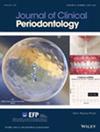Pharmacovigilance-Based Identification and Mechanistic Exploration of Periodontitis-Related Drugs.
IF 6.8
1区 医学
Q1 DENTISTRY, ORAL SURGERY & MEDICINE
引用次数: 0
Abstract
BACKGROUND Periodontitis is a common chronic inflammatory disease. However, drug-related risks and underlying molecular mechanisms remain underexplored from large real-world data. METHODS We first mined the US Food and Drug Administration Adverse Event Reporting System (FAERS) database to identify drugs disproportionately associated with periodontitis, using four signal detection algorithms and logistic regression for confounder adjustment. Identified drugs were then mapped to their protein targets via DrugBank, followed by pathway enrichment and protein-protein interaction (PPI) network analysis to explore biological relevance. To assess potential causality, we conducted Mendelian randomisation (MR) using cis-pQTLs from UKB-PPP and deCODE cohorts. Finally, we used single-cell RNA sequencing (scRNA-seq) data from gingival tissue and peripheral blood of periodontitis patients to evaluate cell type-specific expression of candidate causal genes. RESULTS Five drugs (actonel, aclasta, aredia, amlodipine and avastin) were significantly positively associated with periodontitis based on FAERS. VEGFA showed an association with disease risk (OR = 1.043, p = 0.049) after meta-analysis of two cohorts. scRNA-seq data identified high VEGFA expression in monocytes in both gingival and blood samples of periodontitis patients. CONCLUSION This study uncovered the association between drug and periodontitis and highlighted VEGFA as a potential molecular mediator. Further studies are needed to confirm causality.基于药物警戒的牙周炎相关药物鉴定及机制探索。
牙周炎是一种常见的慢性炎症性疾病。然而,与药物相关的风险和潜在的分子机制仍然没有从大量的现实世界数据中得到充分的探索。方法:我们首先挖掘美国食品和药物管理局不良事件报告系统(FAERS)数据库,使用四种信号检测算法和logistic回归进行混杂校正,以确定与牙周炎不成比例相关的药物。然后通过DrugBank将鉴定出的药物映射到它们的蛋白靶点上,然后进行途径富集和蛋白蛋白相互作用(PPI)网络分析,以探索生物学相关性。为了评估潜在的因果关系,我们使用来自UKB-PPP和deCODE队列的顺式pqtl进行了孟德尔随机化(MR)。最后,我们使用来自牙周炎患者牙龈组织和外周血的单细胞RNA测序(scRNA-seq)数据来评估候选致病基因的细胞类型特异性表达。结果5种药物actonel、aclasta、aredia、氨氯地平、阿瓦斯汀与牙周炎FAERS呈显著正相关。两个队列的荟萃分析显示VEGFA与疾病风险相关(OR = 1.043, p = 0.049)。scRNA-seq数据发现,牙周炎患者的牙龈和血液样本中单核细胞中VEGFA的高表达。结论本研究揭示了药物与牙周炎之间的关系,并强调了VEGFA作为一种潜在的分子介质。需要进一步的研究来证实因果关系。
本文章由计算机程序翻译,如有差异,请以英文原文为准。
求助全文
约1分钟内获得全文
求助全文
来源期刊

Journal of Clinical Periodontology
医学-牙科与口腔外科
CiteScore
13.30
自引率
10.40%
发文量
175
审稿时长
3-8 weeks
期刊介绍:
Journal of Clinical Periodontology was founded by the British, Dutch, French, German, Scandinavian, and Swiss Societies of Periodontology.
The aim of the Journal of Clinical Periodontology is to provide the platform for exchange of scientific and clinical progress in the field of Periodontology and allied disciplines, and to do so at the highest possible level. The Journal also aims to facilitate the application of new scientific knowledge to the daily practice of the concerned disciplines and addresses both practicing clinicians and academics. The Journal is the official publication of the European Federation of Periodontology but wishes to retain its international scope.
The Journal publishes original contributions of high scientific merit in the fields of periodontology and implant dentistry. Its scope encompasses the physiology and pathology of the periodontium, the tissue integration of dental implants, the biology and the modulation of periodontal and alveolar bone healing and regeneration, diagnosis, epidemiology, prevention and therapy of periodontal disease, the clinical aspects of tooth replacement with dental implants, and the comprehensive rehabilitation of the periodontal patient. Review articles by experts on new developments in basic and applied periodontal science and associated dental disciplines, advances in periodontal or implant techniques and procedures, and case reports which illustrate important new information are also welcome.
 求助内容:
求助内容: 应助结果提醒方式:
应助结果提醒方式:


